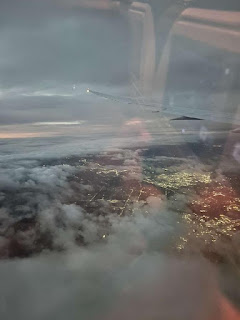Day 8
Our first day on the South Island started off by meeting Rob Pieper, our new tour guide for the remainder of the trip. Rob has a diploma in Horticulture and a BCs in Tropical Animal Husbandry. From his home country, the Netherlands, Rob moved to New Zealand and was able to buy a farm alongside his wife which they made their lifestyle for quite some time. From our hotel stay in Christchurch we made a quick stop to a grocery store “New World” and then traveled to Hawarden for our first farm tour of the day.
 |
| The Tawhai Suffolk Stud Farm Sign |
 |
| Students in sheep trailer that we used as transportation to see farm |
We stopped at Tawhai Suffolk Stud located outside of Hawarden. Penni Loffhagen is the owner of the sheep and beef cattle farm. She has about 650 acres of land around the farm which consists of paddocks and other crops planted into paddocks. Overall, she has about 1,200 breeding ewes of all different breeds which includes Suffolks, Gotland, and Romney. Additionally, they have a small herd of crossbred beef cattle. In the past, they mainly had Suffolks and sold lots of rams, but now they only sell about 30-40 rams each year.
 |
| Bags of Wool from Gotland, Romney, Suffolk at Tawhai Suffolk Farm |
 |
| Wool Shop at Tawhai Suffolk Farm |
 |
| Horses at the Tawhai Suffolk Farm |
From Tawhai Suffolk Stud farm we traveled to Patoa Farms for our second farm visit of the day. Patoa is an outdoor pig farm which is located on the south bank of the Hurunui River in North Canterbury. This is one of New Zealand’s largest pig farms with around 5,300 hogs. This consists of 5,000 sows and 300 boars.
 |
|
Sow and piglets in lactating paddock at Patoa Farms |
 |
|
Dry sows in paddock at Patoa Farms |
The sows are kept in an outdoor arrangement that is constructed to be like the pig’s natural habitat. Sows are separated into two types of housing: lactating paddock or dry sow paddock. The lactating paddocks consist of small personal sheds for each sow and the dry sow paddocks have larger sheds that house multiple sows. The farm also has a small herd of sheep of which they use to graze paddocks before sows enter. When gestating sows first enter their paddock they choose a shed and continue to live in the same shed throughout this parity. These sheds are bedded with straw which is changed out between each sow group. When gilts are first released into their paddocks for the first time, they sometimes need some help to find a shed to themselves in lactating paddocks. When sows have their piglets in the lactating paddocks their sheds are designed in a triangular shape to prevent sows from crushing piglets. In the U.S. we use farrowing stalls to house sows by themselves at this same time in their pregnancy. These piglets then stay with their mom in the paddock until they are weaned; Patoa farms weans about 1,800 piglets a week.
 |
| Gilt piglets in nursery at Patoa Farms |
When weaned the piglets are sorted into pens depending on weight and sex. From here they grow until they will be taken to be processed or used as breeding stock. Overall Patoa farms provided us with a different and interesting concept of pork production.
 |
| Cashmere Hill Lookout overlooking Christchurch and Pacific Ocean |
After the conclusion of our farm tours of the day we headed towards Ashburton where our hotel for the night is. On our way we stopped in Christchurch where we saw many landmarks such as the Christchurch Cathedral and stopped at the Cashmere Hill Lookout where we were able to see the beautiful views of Christchurch, the Southern Alps, and the Pacific Ocean. We then concluded our night with a dinner at Hotel Ashburton.



Comments
Post a Comment